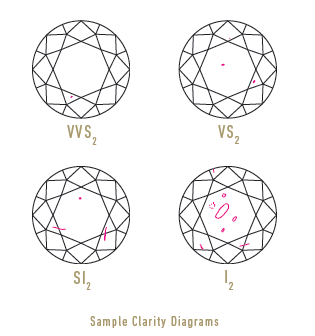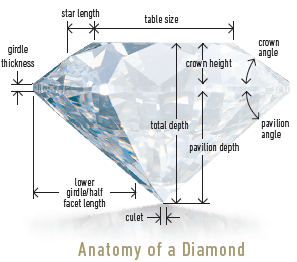Diamonds
Engagement Rings & Wedding Rings
There is no other gemstone quite like a diamond…
It is found in the most remote places on earth, and the fact that it forms at all is something of a miracle. It takes about one ton of rock to recover less than half a carat of rough, making the diamond one of the rarest and most desired gemstones in the world. A diamond is not only a testament of endurance and strength but not surprisingly it’s the ultimate symbol of love.

Color
The GIA Color Scale extends from D (colorless) to Z (light yellow or brown).
Although many people think of gem-quality diamonds as colorless, truly colorless diamonds are very rare. Most diamonds used in jewelry are nearly colorless with tints of yellow or brown.

Color grades are determined by comparing each diamond to a master set. Each letter grade represents a range of colors and is a measure of how noticeable a color is.
Fluorescence: Some diamonds can emit visible light when exposed to ultraviolet radiation, but fluorescence is not a factor in determining color or clarity grades. However, a description of its strength and color is provided on GIA Reports as an additional identifying characteristic.
Clarity
The GIA Clarity Scale includes eleven clarity grades ranging from Flawless to I3.
Because diamonds form under tremendous heat and pressure, it is extremely rare to find a diamond that lacks any internal and external characteristics. These characteristics are a by-product of its formation and help gemologists separate natural diamonds from synthetics and stimulants, and identify individual stones.

Cut
The GIA Cut Scale ranges from Excellent to Poor.
A polished diamond’s beauty lies in its complex relationship with light. The magnificent display you see is made up of three attributes: Brightness is the combination of all-white light reflecting from the surface and interior of a diamond. Fire describes the “flares” of color emitted from a diamond. Scintillation describes the pattern of light and dark areas and the sparkle you see when the diamond, the light, or the observer moves.

A diamond’s proportions affect its light performance, which in turn affects its beauty and overall appeal. Diamonds with fine proportions, symmetry, and polish optimize their interaction with light and have increased brightness, fire, and scintillation. GIA assesses these factors for standard round brilliant diamonds in the D-to-Z color range.
Carat Weight
One carat equals 200 milligrams in weight.
For diamonds under one carat, each carat is divided into 100 points – similar to pennies in a dollar. 0.75 ct. = 75 points, 1/2 ct. = 50 points.

Beauty and Its Beholder
The 4Cs provide a way to objectively compare and evaluate diamonds, but numbers alone can’t describe a diamond’s mysterious and captivating beauty – for that, you’ll have to visit Lambert's Design Jewelers to see one for yourself.
